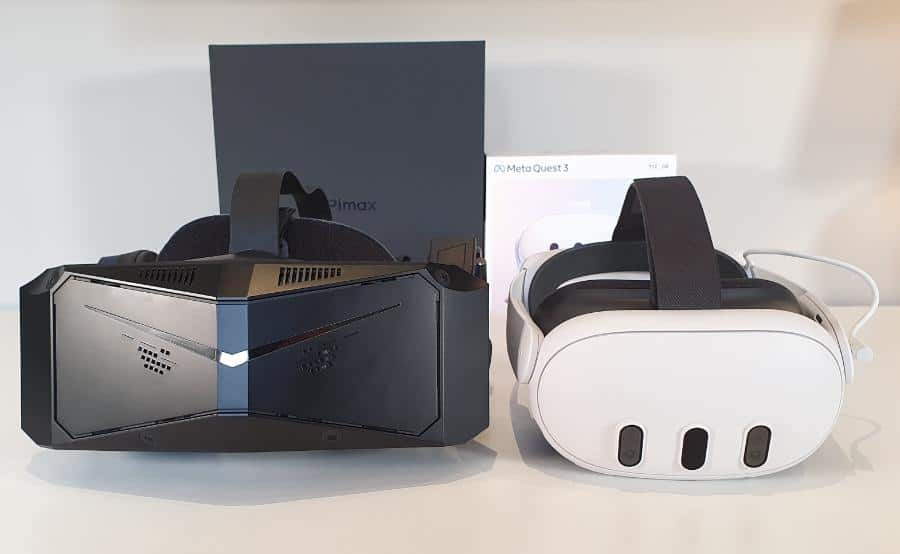
Choosing the right VR headset for flight and racing simulators has always been a balance between quality and affordability. Enter the Meta Quest 3 and Pimax Crystal – two headsets that represent different ends of the VR spectrum. With the Quest 3’s release, we’ve witnessed significant strides in standalone VR technology, featuring enhanced lenses, improved screen resolution, superior display panel quality, and an expanded field of view (FOV). These upgrades have narrowed the gap with more capable, PC-tethered headsets, making the Quest 3 an unexpectedly formidable contender for VR simulator enthusiasts.
On the other hand, the Pimax Crystal, with its higher price tag, caters to a more niche market. It’s the embodiment of high-end VR, offering unmatched visual clarity to satisfy even the most demanding flight and racing simulator fans. However, this superiority comes at a cost, not just in dollars but in terms of comfort, bulk, and the necessity for greater technical know-how and troubleshooting acumen.
This article delves into the nuanced world of VR headsets for simulator enthusiasts. We’ll compare the Meta Quest 3 and Pimax Crystal across various aspects crucial to an immersive simulator experience. While the Pimax Crystal might be the ultimate choice for the hardcore aficionado, the Meta Quest 3, with its significant improvements over previous standalone VR headsets, presents itself as a surprisingly competent and far more accessible alternative. For many, the Quest 3’s combination of lower cost, ease of setup, user-friendly software, and comfort could make it “good enough”, striking a perfect balance between performance and practicality.
Pimax Crystal Vs Meta Quest 3: Specifications
| Feature / Specification | Meta Quest 3 | Pimax Crystal |
|---|---|---|
| Display Type | Dual LCD | Dual QLED + Mini-LED |
| Resolution (per eye) | 2064×2208 per eye | 2880 x 2880 |
| Pixels Per Degree (approx) (PPD) | 25 | 35 |
| Lenses | Pancake | Aspheric glass lenses |
| Refresh Rate (Hz) | 72/90/120 | 72/90/120 |
| Field of View (FOV) | 110° horizontal, 96° vertical | 120° (Horizontal – Approximate) |
| IPD Range (mm) | 53–75mm (Manual) | 58-72 (Manual and Automatic) |
| Audio | Built-in stereo speakers | Off-ear stereo speakers (Optional DMAS) |
| Tracking Type | Inside-out | Inside-out and SteamVR Tracking |
| Eye Tracking | No | Yes |
| Weight (g) | 515g (with fabric strap) | 960g including battery |
| Price | $499.99 / £479.99 (128GB) $649.99 / £619.99 (512GB) | $1600 (with controllers) $1449 (Crystal Sim Edition) |
I’ve been using the Pimax Crystal since August 2023 and I bought the Meta Quest 3 on day one of release in October 2023. I’ve spent countless hours using both headsets with PC VR flight simulators such as DCS World and Microsoft Flight Simulator and also tested both headsets with a range of VR racing sims including Assetto Corsa.
I’ve had plenty of opportunities to form opinions and see the pros and cons of both headsets for PC VR simulation fans. It might seem a little unusual that I am comparing two headsets that have such a price difference, but I think this is an important comparison if you are thinking about getting a VR headset to play VR racing or flight simulators, or if you are considering upgrading from an older headset.
Before I go into the specifics of both headsets, I want to give you the bottom line about my experiences, and who I think will benefit most from each headset.
Who Should Choose Meta Quest 3 For PC VR Flight and Racing Simulation?
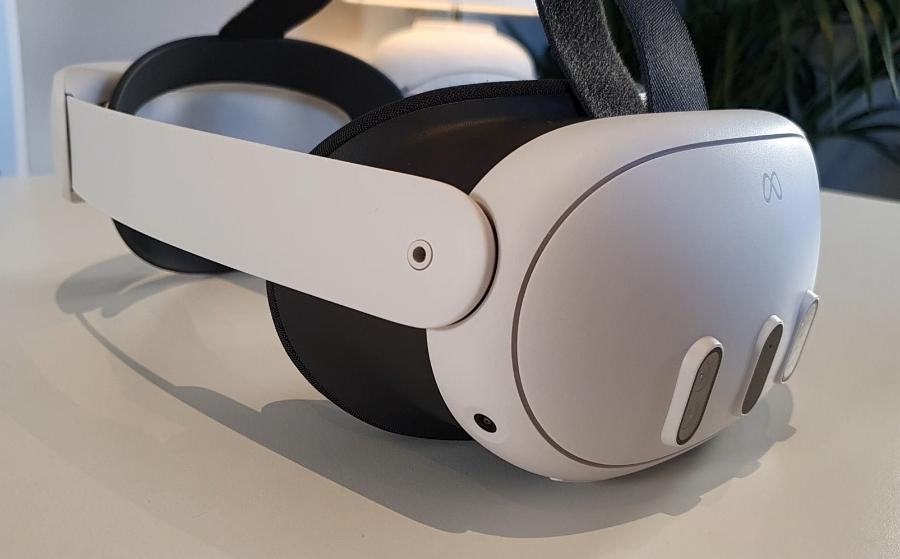
Meta Quest 3 is a huge step up in every way compared to the Meta Quest 2 and is able to provide dramatically better visual clarity. The Meta Quest 3 is sufficiently good enough for anyone who wants to enjoy PC VR simulators on a regular basis. With its exquisite pancake lenses, dual LCD panels offering a resolution of 2064 x 2208 per eye and a horizontal FOV of 110°, it provides a level of clarity that will allow you to truly enjoy the experience of flying or racing, without technical limitations getting in the way.
Whilst the screen resolution and pixels per degree are lower than the Pimax Crystal, and the USB-C or wireless connection results in some compression of the video signal, these are minor compromises when considered alongside the benefits and the value proposition that this headset provides.
With the addition of an Elite head strap and external battery, Meta Quest 3 becomes an incredibly well-rounded VR headset that excels in its versatility.
Quest 3 is extremely user-friendly and you can typically jump into your favorite PC VR racing or flight simulator within 1-2 minutes, and there are rarely any technical issues to cause frustration. The level of visual clarity is more than good enough for most people, but it does pale in comparison with the Pimax Crystal.
If you are looking for your first VR headset to enjoy PC VR simulators, Meta Quest 3 would be my recommendation for most people.
Who Should Choose Pimax Crystal?
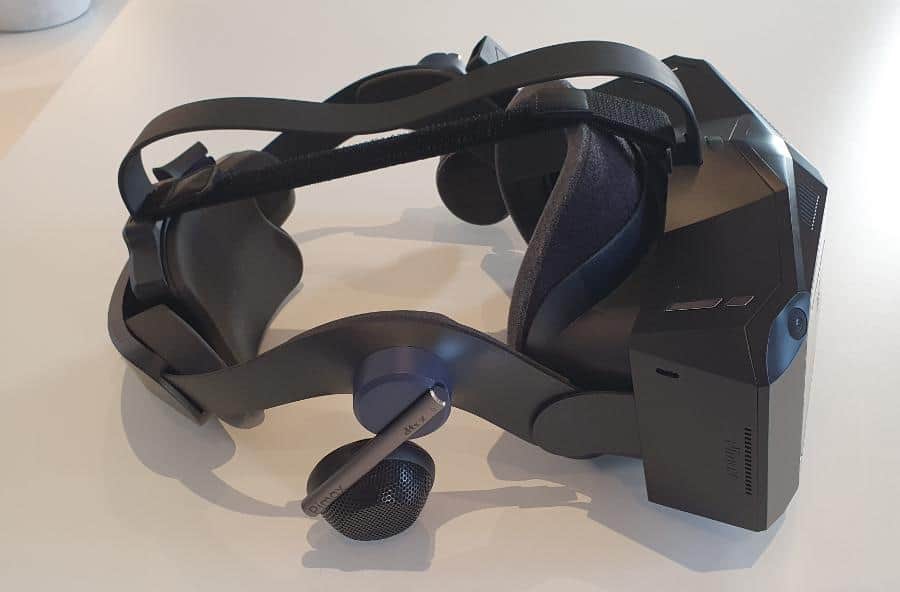
Pimax Crystal stands at the pinnacle of what PC VR headsets can offer at present in terms of visual fidelity. The glass aspheric lenses, 120° horizontal FOV, QLED LCD panels with 2880 x 2880 resolution per eye, automatic IPD adjustment, and eye tracking all combine to create the most visually stunning and incredibly clear visuals that I have ever encountered in a VR headset.
It represents a big step up from almost every other PC VR headset and greatly improves my enjoyment of and ability to perform well in a range of flight and racing simulators. However, this headset is pushing the limits of what is currently possible, and with that comes a list of compromises and drawbacks, which you must consider.
Pimax Crystal is a bulky and reasonably heavy headset that I would only recommend for seated VR experiences. For room-scale activities, there are better, more compact options. Pimax Crystal is only moderately comfortable at best, and the front-weighting can make it a little uncomfortable to use for long periods.
As a consequence of the very high resolution, you will need a high-end computer to be able to run most games at a satisfactory frame rate. I use a GeForce RTX 3090 and Ryzen 7 5800X and I would consider these to be close to the minimum hardware requirements to run either DCS World or Microsoft Flight Simulator with Pimax Crystal and still achieve reasonable frame rates.
Pimax Crystal has worked admirably well for me during my time using it, but the software is still relatively temperamental, and I do need to do a little troubleshooting from time to time with specific games. This is an area that Pimax has been working hard to improve, and I can see the huge progress they have made in their software over the last few months. You can read or watch my full review of Pimax Crystal here.
If you are an enthusiastic VR simmer who prioritizes visual fidelity above other features, has the budget to afford Pimax Crystal and a high-end PC, and are prepared to put up with some rough edges and compromises, I can confidently say that you will be hugely impressed by Pimax Crystal. It is truly an enthusiast-level product, and in view of the compromises that come alongside its delightful visuals, it should very much be seen as an upgrade for the most enthusiastic VR simmers.
Pimax Crystal Vs Meta Quest 3 Video
In addition to this article, I’ve also made a video comparing how these headsets perform with VR racing and flight simulators. Whilst there’s a big difference in the specs and price of these two headsets, they have a lot more in common than you think. I cover all the pros and cons and share my thoughts about who should get each one.
Visual Fidelity
It’s only natural to want to have the very best experience in VR, and visual clarity is a hugely important part of this. When I first got Pimax Crystal, I remember being blown away by how sharp and clear everything looked in this headset. Small features in the distance look sharp, and I can easily read all of the dials in my cockpit when flying in DCS and Microsoft Flight Simulator.
The degree of visual clarity is better than anything I have ever experienced in other VR headsets, and coupled with the slightly increased FOV, the sense of immersion and presence that I feel when using Pimax Crystal is terrific.
However, although the resolution per eye is impressive, it only results in 35 pixels being displayed per degree across your horizontal FOV, which provides less visual clarity than someone with 20/20 vision sees in real life. We need headsets that can achieve 60 PPD (pixels per degree) before the visual clarity matches human vision, and this will require display panels with at least twice the number of pixels as the Pimax Crystal to achieve this level of clarity at a similar FOV.
As a result, the level of clarity is not yet as good as you experience in the real world, and this can result in some pixelation of objects in the distance, and a slight haziness when looking at more nearby objects.
In contrast, Meta Quest 3 has two panels, each with a resolution of 2064 x 2208, and 25 PPD peak clarity. Whilst there is a big improvement in visual clarity when moving from Meta Quest 3 to Pimax Crystal, it is a less significant improvement than moving from Meta Quest 2 to Meta Quest 3. I do feel we are in the realm of diminishing returns, and Quest 3 will provide sufficient clarity for many people, especially when considering the more wallet-friendly price.
Visual clarity becomes more of an issue in Quest 3 when looking at small objects in the distance such as when undertaking aerial combat, where the additional fidelity makes a big difference to both my enjoyment and ability to perform well.
DisplayPort Vs USB-C
One of the big advantages of Pimax Crystal over Meta Quest 3 is using a DisplayPort cable to connect the headset to your PC. This results in uncompressed video signals being transmitted to the displays on your headset from your computer, preventing any loss of clarity in the rendered images.
In contrast, Quest 3 uses a USB-C cable that is not capable of transmitting the full uncompressed signal down the cable to your displays. This produces graphical artifacts in the image at times, particularly when viewing monochromatic dark or light colors.
Whilst some users won’t be bothered by this very much at all, other people will find this to be distracting and a bit of a dealbreaker. The situation is worse when you use a Wi-Fi connection between your computer and headset, as the video signal is compressed further.
This can be mitigated to some degree by being as close to your router as possible, ideally in direct line of sight, but it does limit the ability of Quest 3 to compete toe to toe with Pimax Crystal.
The huge advantage that comes with using a Quest 3 wirelessly is the lack of having a cable attached to your headset, which is hard to ignore, and you can often feel pulling on the headset whenever you turn or move your head. For me, the benefits of moving to a wireless headset go quite some distance to compensate for the loss of visual fidelity.
Form Factor And Comfort
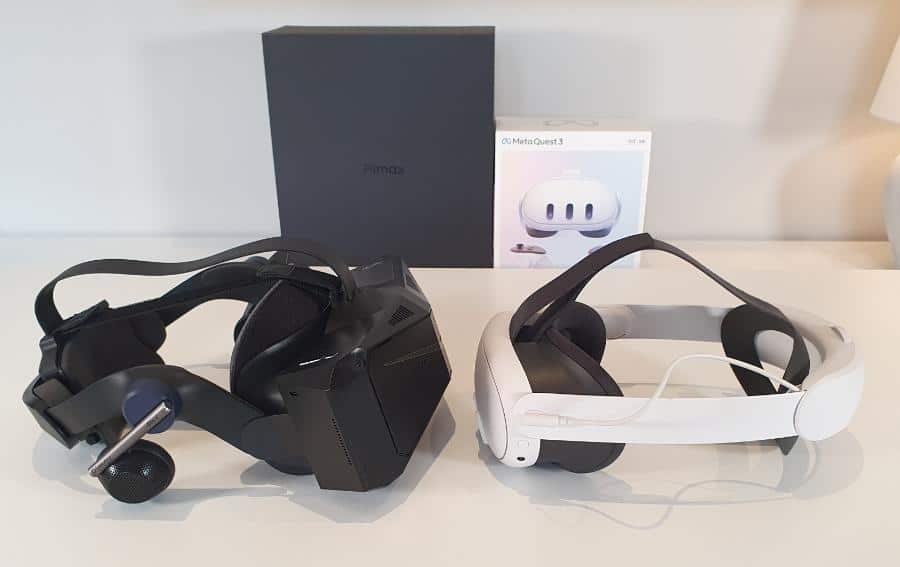
The contrast in the appearance of Meta Quest 3 and Pimax Crystal is quite stark due to the size difference. Meta Quest 3 looks sleek, appealing, and compact. Although Meta Quest scores a lot of points in the design department, the default material head strap is woefully inadequate and makes the headset a bit uncomfortable to use and quite front-heavy. The addition of a suitable battery head strap, such as the official Elite Strap with Battery, or a suitable third-party alternative improves comfort massively, ensuring that it is balanced on your face, and extends the battery life considerably.
I bought the official Elite Strap with Battery for my Quest 3 at launch and I find it to be a very comfortable, well-balanced headset to wear when using this. It looks great and is also comfortable to use for a prolonged period, but buying an additional head strap adds to the cost.
Pimax Crystal is a bulky and front-heavy headset due to the design decisions that have been made in the pursuit of supreme visual clarity. This results in it feeling heavy on your face, and although the head strap does a reasonable job of securing the headset in position, you will need to keep the strap reasonably tight to prevent it from wobbling around your face, which does negatively impact the level of comfort.
I have spent many long hours playing flight simulators using Pimax Crystal, and I can’t say I’ve ever stopped using it due to comfort issues, but it’s certainly not a headset that I would describe as being comfortable, and it does detract from the other impressive features of this headset. Despite it having a rear-mounted battery for use when the headset is in standalone mode, it’s still very front-heavy, and it will press on your nose or cheeks if you don’t position it correctly.
Performance And Software
Meta Quest 3 is a much easier headset to pick up and start using without requiring much technical knowledge. Connecting it to a VR-ready PC via USB-C cable or wirelessly is fairly effortless, and I have encountered virtually no compatibility or technical issues when playing a wide range of content.
As a result of the lower-resolution panels in Meta Quest 3, the hardware requirements are lower, and I can typically achieve a higher frame rate, or push my graphics settings higher in games. I am usually able to maintain the frame rate at the native refresh rate of the displays, avoiding the need for projection.
There is an option to run Quest 3 at a variety of frame rates depending on your preference and hardware configuration, and I often reduce the refresh rate to 72 Hz if I am struggling to maintain a decent frame rate.
My Pimax Crystal has generally worked without a hitch, and I’ve been pretty impressed overall by the Pimax software. I know this hasn’t always been the case, but I think things have improved significantly.
My biggest problem with Pimax Crystal is that my computer struggles to meet the demand of the awesome 2880 2880 displays and achieve a decent frame rate. There is no chance of my computer hitting the native 90 Hz refresh rate, but I normally experience smooth gameplay thanks to projection.
Pimax Crystal recently released a 72Hz refresh mode which allows me to consistently hit half of the native refresh rate or turn up the graphics settings in both DCS and MSFS. If you don’t have at least an RTX 3090, or RTX 4080 or better, your system is really going to struggle to meet the demands of Pimax Crystal, and it may be worth thinking again.
I have also encountered some minor bugs where performance is horrendously low, but the issue is resolved after I restart both my computer and the headset. I have had occasional issues with the render resolution within Steam being randomly set way too high, but generally, I’ve had a pretty smooth experience.
A recent software update to Pimax Crystal enabled the use of integrated eye-tracking for foveated rendering, and this has led to a significant improvement in performance, so I’m confident that Pimax Crystal is on the right track. Thankfully, the visuals just look so so good, that it is well worth the extra bit of work to ensure that things run smoothly.
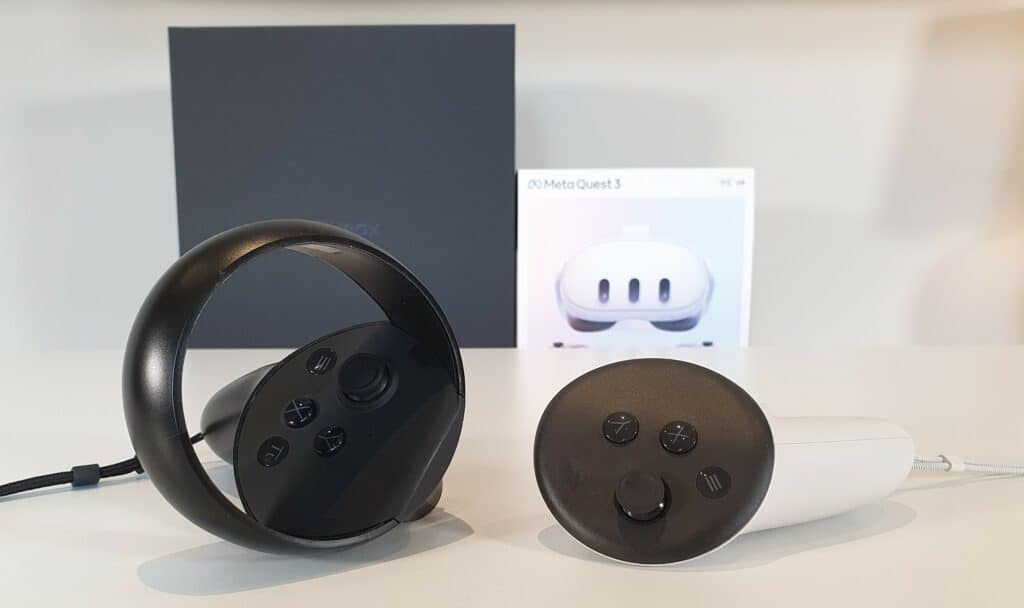
Sound
I’ve been really impressed with the off-ear speakers on Pimax Crystal, which I have found to be at least as good as the excellent speakers on Valve Index and HP Reverb G2. Whilst I’m by no means an audiophile, I have found them to be everything I need in a sound solution for a top-tier VR headset.
Meta Quest 3 also does a reasonably good job in the audio department, with speakers that are integrated into the side arms of the headset. Whilst clearly not as impressive as Pimax Crystal, I’ve still been fairly pleased with the audio. Quest 3 has an integrated 3.5mm audio jack on the right side arm, so if you’d prefer to use your own audio solution, you can just plug in a suitable pair of headphones, so I think this should keep most people happy.
Latency
Another issue to bear in mind is that using Meta Quest 3 will introduce a little more latency into your experience compared to Pimax Crystal, particularly when using a wireless connection. Whilst this will usually be imperceptible, it can start to become an issue when playing very fast-paced games via a wireless connection, particularly if your router is not in direct line of sight to your headset when using a wireless connection.
I cannot imagine this being an issue for anyone playing a flight simulator, but I’m not a sufficiently competent racer to know if this starts to cause issues at a highly competitive level. Realistically, if you’re competing at a high level, you won’t be using a headset such as Quest 3, and I think that for 99% of people, it will be almost imperceptible.
Cost
I can’t write this article without discussing the cost of both of these headsets. There is a huge discrepancy in the cost which may make you wonder whether this is a fair comparison at all. However, I think it’s still a really interesting comparison for a number of reasons. At first glance, Meta Quest 3 costs about $500 (£479) and Pimax Crystal costs $1600. However, you will definitely need to get a better head strap for the Quest 3. I actually purchased the 512GB model for £620 and bought the Elite Strap with Battery for £130, bringing the total cost to £750.
Pimax Crystal currently costs $1600, or you can get a Crystal-Sim version that comes without controllers for $1449 (about £1200). You also get a significant trade-in value against their upcoming Pimax 12K headset, which may help to make the price easier to bear. Whilst this is still a big price difference, if you are a true VR racing or flight sim enthusiast, it may start to become a more difficult decision.
When you consider the alternatives to Pimax Crystal, you will find that many of them, such as the HTC Vive Pro 2 and Varjo Aero both require external tracking stations, which push the price up a lot. Considering it offers pretty much the best visual clarity of any consumer VR headset right now, the price maybe isn’t quite as bad as it first appears.
On the other hand, I have to commend Meta Quest 3 for providing terrific visual clarity and features for the money. It is an amazing mainstream VR headset and it is genuinely good enough to use and enjoy VR flight simulators and racing simulators with minimal compromise. For all but the most hardcore enthusiasts, Meta Quest 3 is good enough right now, and offers terrific value.
Meta Quest 3 Vs Pimax Crystal: Clarity Vs Convenience
From my perspective, the choice between these headsets boils down to what you value most in your simulator experience. If uncompromised visual clarity and zero latency are your top priorities, the Pimax Crystal’s DisplayPort connection is unrivaled. Its ability to deliver an unadulterated, high-resolution VR experience directly reflects in the quality of every simulation.
Conversely, if you’re someone who values ease of use, comfort, and the flexibility of a wireless option, the Meta Quest 3 is more than adequate. Its versatility and user-friendly nature make it a great choice for those who play flight or racing simulators more casually. While its image quality doesn’t match the Pimax Crystal, it still represents a significant leap over previous standalone VR headsets. The slight compromise in visual fidelity is a small price to pay for the convenience and accessibility it offers.
In conclusion, the Pimax Crystal, with its DisplayPort connection, is the go-to choice for simulator enthusiasts who demand the highest level of detail and realism. The Meta Quest 3, meanwhile, offers a more balanced experience, catering well to those who prefer a blend of convenience and quality in their VR endeavors.
